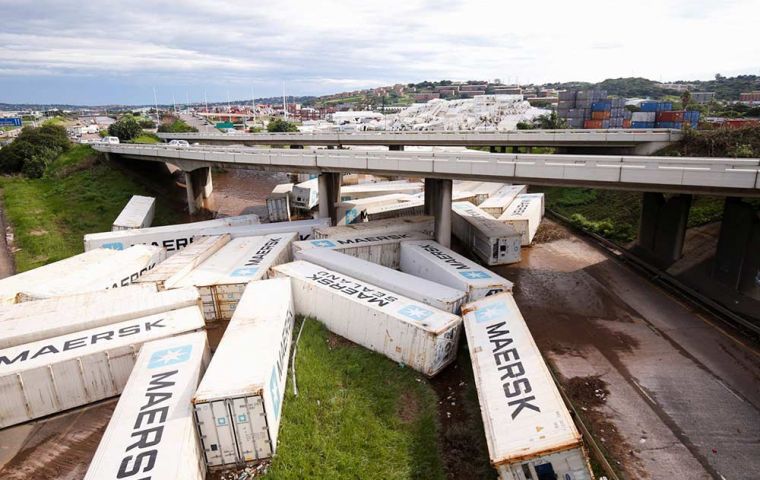MercoPress. South Atlantic News Agency
Nearly 400 killed in “Biblical” South African floods
 The Port of Durban, one of the largest and busiest in Africa, has been hard-hit, and incoming shipping is being redirected to Coega, about 900km southwest of Durban. (Pic Reuters)
The Port of Durban, one of the largest and busiest in Africa, has been hard-hit, and incoming shipping is being redirected to Coega, about 900km southwest of Durban. (Pic Reuters) Devastating floods throughout the whole week in South Africa have left at least 395 people dead by Friday and countless families displaced from their homes. While relief work continues, weather forecasts are anything but encouraging.
The meteorological catastrophe focused on the province of KwaZulu-Natal. Authorities have admitted the number of fatalities is bound to grow as rescue operations progress. One official described this year's storm as “Biblical.”
Provincial Councilor for Cooperative Governance and Traditional Affairs, Sipho Hlomuka, said most of the deaths occurred in the metropolitan area of the port city of Durban, the most populous city in KwaZulu-Natal and the third largest in South Africa. There were also significant casualties in iLembe.
He also explained that some 40,723 people needed to be evacuated from their homes fully immersed in water and with electricity and running water services interrupted in all the adjacent areas.
Several roads were also cut off and more than 2,000 homes were destroyed, in addition to the 4,000 informal homes. Garrith Jamieson, a member of a rescue squad, described the situation to AFP as a nightmare.
Finance Minister Enoch Godongwana announced resources were available to help the victims in the amount of 1 billion South African rands (about 63 million euros).
President Cyril Ramaphosa referred to these events as “a tragic cost of the force of nature and this situation requires an effective response from the government.”
The province has also been hit lately by a series of late-season cyclones and tropical storms. The area is otherwise quite used to ordinary tropical seasonal rains, but this time around rains and winds were so extreme that cargo-filled containers were washed out of their storage areas and ended up floating down roads, including on a major highway in Durban, it was reported.
“Nobody ever thought of this situation,” said a shocked KwaZulu-Natal premier Sihle Zikalala, in reaction to the extent of the damage and the growing loss of life and livelihoods.
The premier said emergency responders were “working hard to restore services”, including electricity, water, and road access.
The Port of Durban, one of the largest and busiest in Africa, has been hard-hit, and incoming shipping is being redirected to Coega, about 900km southwest of Durban. Supplies of a wide range of goods imported through Durban to other African neighboring states have also been effectively halted or will be delayed after being rerouted.
Back in 2017 and 2019, less severe storms took the lives of around 150 people. The 2022 flooding has made prior rainfall disasters seem relatively minor.
Along with rioting, looting and the arson attacks of last July, following the jailing of former President Jacob Zuma, and from which the regional economy was just beginning to recover, the recent extreme weather impacting KwaZulu-Natal has left the province reeling.
Among severely-impacted industries was a major Toyota manufacturing and warehousing plant, with production and storage facilities submerged along with hundreds of new vehicles, now all write-offs.
With additional heavy rain forecast, fears were being expressed by both officials and citizens of what may be coming up next, should the inundations resume this weekend and into next week, as expected.




Top Comments
Disclaimer & comment rulesCommenting for this story is now closed.
If you have a Facebook account, become a fan and comment on our Facebook Page!